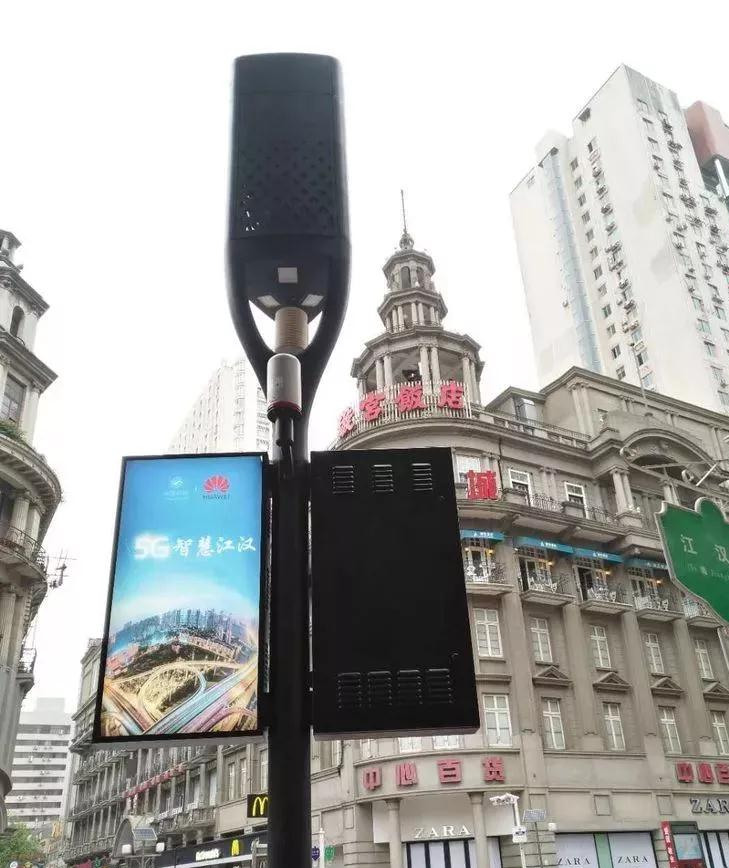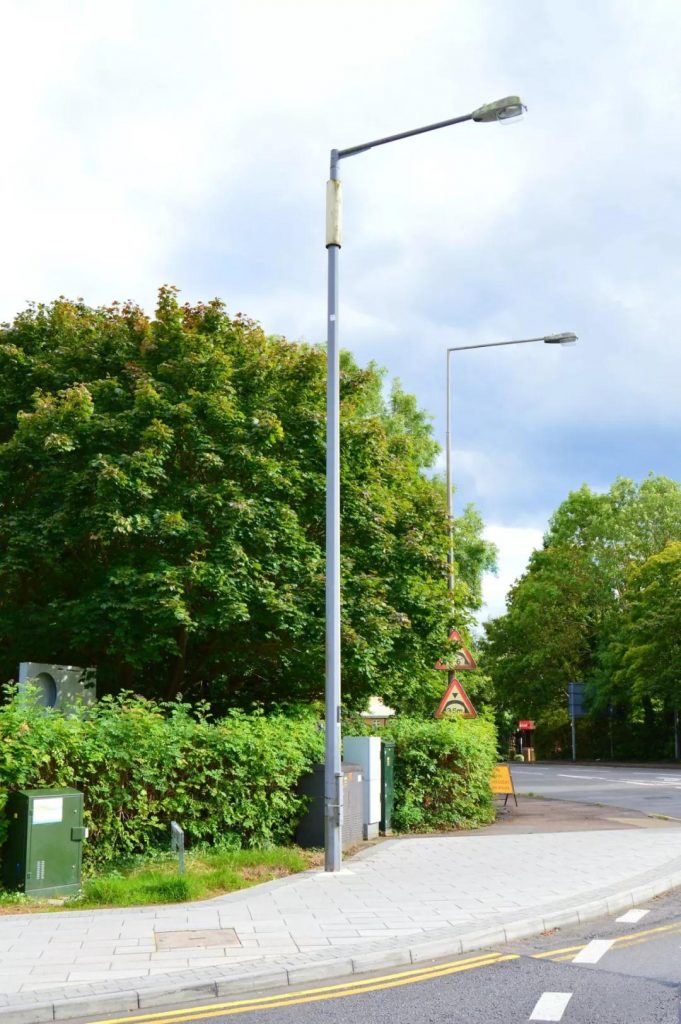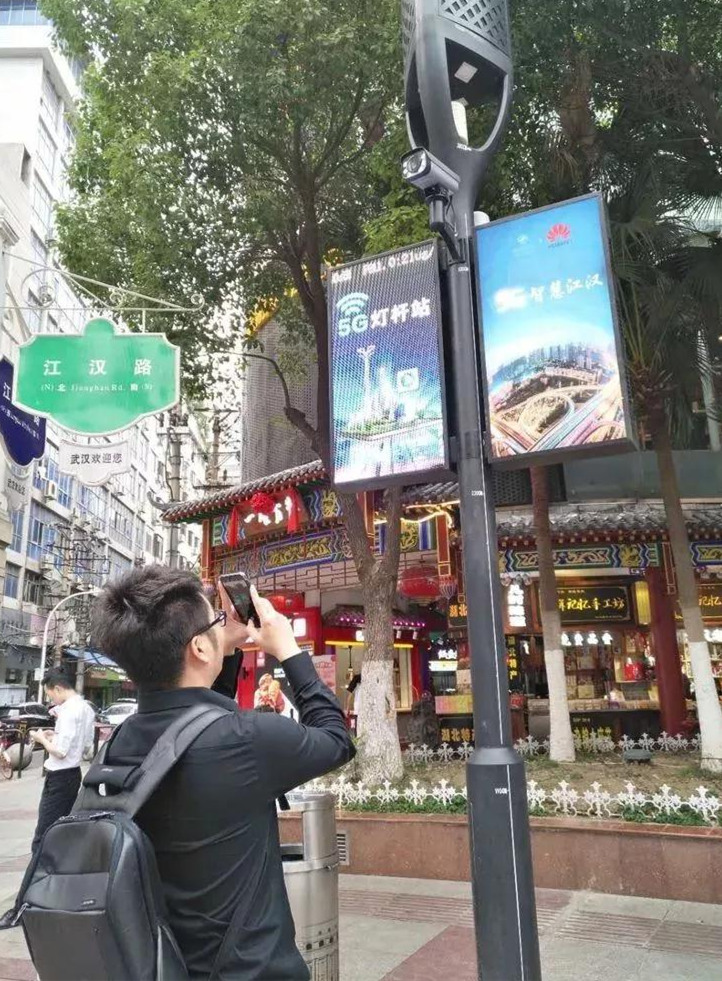Hsinchu people – China’s First 5G Smart Street Light Debuts at Nanliao Fishing Port
Central China’s first 5G smart light pole debuts on Jianghan Road
China : In the 5G era, the spring of Smart Light Poles is here
Central China’s first 5G smart light pole debuts on Jianghan Road
ZTE, China Unicom Announce Commercialization of Magic Pole Small Cell Solution
March 30, 2018
ZTE Corporation, in association with the Shaanxi arm of China Unicom, announced the commercialization of ZTE’s Magic Pole Small Cell solution in Xi’an, China. The solution uses the street light pole as a carrier, integrating the wireless infrastructure and an advertising board in a compact structure that matches the surroundings and is easy to deploy.
As wireless data usage has skyrocketed in recent years, all major operators are confronted with the challenge of increasing the density of network coverage to meet the growing demand and improve user experience. Considering environmental protection, high entry fees and difficulties in site selection and acquisition, there are many restrictions to the deployment, operation and maintenance of macro base stations, as well as distributed base stations.
To address these challenges, ZTE developed an innovative solution: the Magic Pole. Magic Pole, featuring a clean and sleek appearance and wireless backhaul, avoids trenching and laying optical fiber. Integrated with a solar street lamp on the pole, Magic Pole provides intelligent control of street lamps and significantly reduces electricity cost. The pole is equipped with outdoor, small-pitch, full-color LED display screens that run commercial and public service advertisements, helping Shaanxi Unicom generate advertising revenue and providing information to residents.
These small cells will greatly improve network quality during the rush hour of Chang’an Communication Industrial Park in the high-tech development zone of the city.
Huawei’s Super BladeSite Adopted Worldwide
PRESS RELEASE: In 2019, Huawei unveiled its 5G simplified site solution, Super BladeSite. To date, it has been widely adopted worldwide, including Russia, the UK, Switzerland, Argentina, and so on.
The Super BladeSite solution has the characteristics of full-outdoor and modular. It can make full use of the existing site resources to reduce the dependence of 5G deployment on site resources, realize the “one pole for one site” concept, and eliminate the need for equipment rooms and air-conditioners, thereby simplifying 5G site deployment and greatly reducing site TCO.
In Russia, 37% macro sites on live networks are using monopole towers. Due to low device integration, the remaining space is not enough to support 5G evolution. In this case, Super BladeSite needs only half less space to deploy. 50% of costs can be saved, and 40% less time is required for device installation, enabling quick 5G construction.
n the UK and Switzerland, insufficient pole resources hold back quick 5G deployment. BladeAAU integrates passive multi-band antenna and an AAU in a single box. The passive antenna can support all sub-3 GHz bands, while the active antenna supports C-band massive MIMO. Therefore, BladeAAU delivers an ideal solution to one-pole-for-one-sector scenarios, enabling 5G quick deployment.
In Argentina, high TCO and long TTM are long standing bottlenecks for new site construction. Super BladeSite’s full-outdoor modules can all be mounted on poles, such as dual-band BladeRRU, BladeBBU, BladePower, BladeBattery, and highly integrated antennas. It simplifies site acquisition, saves space, and retains a friendly environment. Compared with traditional rooftop sites, Super BladeSite reduces CAPEX by 20%, OPEX by 43%, and TTM by 52%, improving construction efficiency.
“Huawei has been always innovating products and solutions based on customer requirements to make products and solutions as simple as possible for customers. Super BladeSite is one paragon of this effort. This solution eliminates the need for equipment rooms for outdoor sites and simplifies antenna deployment in the 5G era. It enables telecom operators to easily deploy massive MIMO to speed up 5G construction. Huawei will continue to help customers achieve greater success,” said Ma Hongbo, President of Huawei Wireless SingleRAN Product Line.
from Paul Doyon http://emfrefugee.blogspot.com
5G and COVID-19 in China
At least 10,000 5G Antennas Installed in Wuhan Alone
What has not been apparent in the news reports is the fact that China in its rush to take the lead in the 5G race, had by the end of 2019 (and mostly within the last several months leading up to the COVID-19 outbreak) installed 130,000 5G antennas throughout the country,[40] with at least 10,000 antennas installed in Wuhan alone.[41]
(As a comparison, the USA only has approximately 10,000 5G antennas presently installed throughout the whole country.)
“Wuhan City, the capital of Hubei, is expected to have 10,000 5G base stations by the end of 2019…” 41
“According to previous reports, the three operators were expecting to operate nearly 130,000 5G base stations by the end of 2019.” [42]
Wuhan: One of the Initial Cities Trialing 5G
In fact, Wuhan was one of the initial 16 cities selected to trial 5G back in 2018.
China Unicom will begin testing 5G network in 16 cities including Beijing, Tianjin, Qingdao, Hangzhou, Nanjing, Wuhan, Guiyang, Chengdu, Shenzhen, Fuzhou, Zhengzhou, and Shenyang.
China Mobile will conduct external field test and set up more than a hundred 5G base stations in each of the following five cities: Hangzhou, Shanghai, Guangzhou, Suzhou, and Wuhan.[43]
From the article, “Wuhan 5G Industry Development: Five-Chain Coordination, Three-Wheel Drive,” (武汉5G产业发展:五链统筹 三轮驱动),[44] (written in Chinese) published October 11th, 2019, it becomes clear that Wuhan was in a race with other Chinese cities to position itself at the forefront of 5G technology, and with approximately 10,000 5G antennas, is probably one of — if not the most — 5G-radiated city in China:
At present, Wuhan is seizing major developmental opportunities in 5G commercialization, with the construction of a national first-class 5G network as a guide, with the development of a national first-class 5G industry as the main body….
…Wuhan City has fully implemented the “Wuhan 5G Base Station Planning and Construction Implementation Plan,” with an extraordinary policy effort, to guide and support basic telecommunications companies and China Tower Corporation to accelerate the construction of 5G networks. This year and next, Wuhan will build more than 20,000 5G base stations, form a 5G basic network with leading scale, first-class quality, and strong demonstration to ensure full coverage of the 5G network in the city and be at the leading level among similar cities in the country.44
Finally, it was stated in an article titled “5G network coming to Wuhan,” (April 16, 2018), that “3,000 macro base stations and 27,000 micro base stations” would soon be constructed, and that by 2020, the “5G network will cover every corner of the city and be available at an affordable price.”[45] This means that there may in fact be a lot more than just 10,000 antennas in Wuhan, though 10,000 alone would make Wuhan one of the most 5G concentrated cities in the world.
5G Systems Deployed in Hospitals
What is also disconcerting here is that China has, since about November of 2019, been installing 5G systems in its hospitals.[46] [47] [48][49]
“Key Chinese hospitals, leading telecom carriers and Huawei Wednesday launched a project to establish standards for 5G-based networks in hospitals.” 46
“China released a pioneering standard for its 5G hospital networks, following a joint drafting and verification process between the medical and telecommunication industries.” 47
5G Systems Installed at Wuhan Coronavirus Hospitals
And to seemingly add insult to injury here, Huawei was very quick to install 5G systems in the new coronavirus hospitals — Wuhan Volcan Mountain Hospital and Thunder Mountain Hospital — the two hospitals known for only being built in just over a week.[50] [51] The two articles cited here are ironically titled, (1) “Huawei installs 5G in China Hospital to fight Coronavirus,” and (2) “Huawei builds 5G in Wuhan Hospital, aims to indirectly fight the Coronavirus” as this might very well be the complete opposite of what they are indeed intending to do here. There is also an interesting video on YouTube entitled “Chinese hospitals deploy robots to help medical staff fight coronavirus outbreak,”[52] demonstrating this in action.
Chinese Telecoms Started Offering 5G Commercially in Nov, 2019
The Chinese telecom companies started to offer commercial 5G services to its customers on the first of November last year.
China’s three major wireless carriers— China Mobile, China Unicom , and China Telecom —will begin selling 5G services to consumers on Friday, November 1st in 50 major cities, including Beijing and Shanghai, said Chen Zhaoxiong, vice minister of the Ministry of Industry and Information Technology on Thursday October 31st at a Beijing conference….
The Chinese government has made building 5G a national priority, clearing red tape and reducing costs so the three wireless providers introduce the new technology as swiftly as possible. “They’ve made this a national priority. It’s part of the [Communist] Party‘s ability to show that it’s delivering the goods,” said Paul Triolo, head of geo-technology at the Eurasia Group consultancy. “And in the middle of the trade dispute and the actions against Huawei, it’s even more important for China to show that they are continuing to move forward despite all these challenges,” he added….
China’s central government wants 5G coverage extended to cover all of Beijing, Shanghai, Hangzhou and Guangzhou by the end of the year. The country’s largest carrier, China Mobile, which has 900 million cellphone subscribers, says it will be able to offer 5G services in more than 50 cities this year….
Approximately 13,000 5G base stations have been installed in Beijing, the communications administration said this week. About 10,000 are already operating. China already has a total of more than 80,000 5G macro base stations, typically cellular towers with antennas and other hardware that beam wireless signals over wide areas, government officials said. They said China will end the year with about 130,000, while Bernstein Research estimates South Korea will be in second place with 75,000, followed by the U.S. with 10,000. Piper Jaffray estimated that of the 600,000 5G base stations expected to be rolled out worldwide next year, half will be in China.40
This basically means that China had suddenly turned on the 5G switch, just less than two months before the COVID-19 outbreak, suddenly blanketing many cities with this 5G wireless radiation. And as of this writing, South Korea’s numbers of COVID-19 cases have also skyrocketed. As we can see from the above article, South Korea has the second highest number of 5G antennas with 75,000. That is a lot for a country its size. Is there a connection? I think there is with at present (March 8th, 2020) also the highest number of coronavirus cases (7,134) and one of the highest number of death rates (50) outside of China.
Forty Cities Drinking 5G Service
In the online article, “These 40 Cities Will Drink 5G Service,”[53] published June 7th, 2019, it was revealed that it had been decided that 5G would be launched in 40 cities across China in 2019 by China Mobile and China Unicom (with no specific information from China Telecom yet at that time). Cities on this list included in Zhejiang Province were Hangzhou, Ningbo, and Wenzhou, not to mention places like Beijing, Shanghai, Wuhan, Guangzhou, Suzhou, and Shenzhen. The initial plan it seems, called the “7+33+n” 5G network deployment strategy, was to have full coverage in Beijing, Shanghai, Hangzhou, Guangzhou, Shenzhen, Nanjing, and Xiong’an, with hotspot coverage in the other 33 cities, and then customized 5G networks in so-called “n” cities, though this might have very well changed as other cities seemingly also wanted full coverage (note Wuhan’s installation of 10,000 5G antennas).
Top Most Coronavirus-Hit Provinces After Wuhan: Zhejiang and Guangdong
Interestingly, at one point in this saga, the second most hit (with the COVID-19) provinces were Zhejiang and Guangdong Provinces, (though as of this writing, Zhejiang has now been taken over by Henan).[54] The provinces listed below, in Chinese, and in order of most cases, are (1) Hubei (湖北), (2) Guangdong (广东), (3) Henan (河南), (4) Zhejiang (浙江), and (5) Hunan (湖南).
It has been so bad in Zhejiang Province that Japan, on Feb. 12th, even extended its entry restrictions to virus-hit Zhejiang (at the time was third in number of COVID-19 cases).
It includes the cities of Hangzhou and Wenzhou, which have among the country’s highest concentrations of coronavirus cases. Hangzhou hosts the headquarters of Alibaba Group Holding, while Wenzhou is famed as a cradle of small business.[55]
On the map (Wikipedia) below [56], Zhejiang Province is the darker red province off to the right and Guangdong Province is the darker red one at the bottom. The darkest red province in the middle is Hubei with Wuhan in its center. Henan Province is above Hubei Province and Hunan Province is below it.
These cities (Hangzhou, Wenzhou, and Ningbo) have also been cities selected to trial the 5G in Zhejiang province. We can see from the picture below on the left from Ookla 5G Maps,[57] which tracks 5G deployment around the world,[58] the number of telecoms offering 5G service in various cities in China. The middle map is a zoom-in on Zhejiang province. The numbers represent the number of telecoms servicing the city. In the city of Hangzhou, we can see that all three Chinese telecoms are providing 5G service in the city; whereas in Ningbo, only two are, and in Wenzhou, only one (China Mobile) is. (If you further click on the number, it will tell you which telecoms are operating.) And the picture on the right is a zoom-in of the COVID-19 Map from Expat Focus, in Zhejiang Province, where we can see that the cities with the most 5G antennas are also the ones with the highest cases of coronavirus.
The three cities in Zhejiang Province with the most cases have been Hangzhou (168 cases), Ningbo (156 cases), and Wenzhou (503 cases),[59] which are also curiously the cities selected to trial the 5G. The city proper of Wenzhou itself (though when one includes the outer-lying prefectures the total comes 9 million), for example, with only 200,000 people, has an inordinately high number of people infected with COVID-19, and the city has been on lockdown. But as you can see from some of the articles selected below that there has been a major push in this city to implement and blanket cover their cities with 5G technology.
In the following online article, “China Tower Built 8400 5G Stations in Zhejiang”[60](Oct. 21st, 2019), it is revealed that 8400 5G base stations have recently been installed in Zhejiang Province, with 4775 (out of an order of 6154) installed in Hangzhou alone, and 3200 of these installed within 100 days (in just a little over three months).
China Tower Built 8400 5G Stations in Zhejiang
According to a person in charge of China Tower (Zhejiang), since this year, it has undertaken more than ten thousand 5G construction demands. At present, 8397 stations have been completed, more than 96% of which were built on the stock station sites. In Hangzhou, since this year, 6154 5G demands have been accepted and 4775 have been completed and delivered, of which 93% are directly met and transformed through stock station sites.
In the downtown of Hangzhou, after receiving the 5G construction demand of three telecom enterprises, China Tower (Zhejiang), with the support of the government, completed 3200 5G base stations in the West Lake scenic area, Olympic Sports Center and other scenes within 100 days, and cooperated with telecom enterprises to complete quick installation and debugging of equipment, based on existing telecom rooms, cabinets, power supporting facilities and 5G antenna added on stock station sites, street lamp poles, buildings, etc.60
In another online article, published in Chinese, “China Tower installs 8,400 5G antennas in Zhejiang, 96% based on existing sites,” [中国铁塔在浙江建成8400个5G站址,96%基于既有站址],[61] we can see China Tower blanketing Hangzhou with 5G antennas in a very short period of time.
In this article, it is stated that “Zhejiang is one of the earliest provinces in the country to start building 5G networks,” and that “China Tower Zhejiang Company … started the acceleration of 5G construction in the first year of 5G commercialization…. And further that, “more than 10,000 5G construction requirements have been undertaken since this year,” with “8397 sites … completed.”
It becomes clear that the Zhejiang Province, home to the tech giant, Alibaba, is one of the provinces slated to become one of the first to introduce the 5G. In the following article, “Delta region to build world-class information communication hub,”[62](Updated: 2019-11-01) it is stated that with the commercialization of 5G services on Oct. 31st,
[f]ifty cities were selected to become among the first to access commercial 5G services, including 10 cities in the Yangtze River Delta (YRD) region, half of which are from Zhejiang province – Hangzhou, Ningbo, Wenzhou, Jiaxing, and Shaoxing.
It is further stated that the three telecom companies plus China Tower would be investing in the region a total of 200 billion yuan (USD $28.4 billion) for the 5G infrastructure construction in order to “build it into a world-class information communication hub.”
According to a development plan for the region released in 2016, China Telecom, China Unicom, China Mobile and China Tower are planning to invest more than 200 billion yuan ($28.4 billion) in 5G infrastructure construction in the region by 2021 to help “build it into a world-class information communication hub” promoting the “region’s pilot use of 5G network and applications,” and making “it clear that the YRD region will be the first in China to conduct trial commercial use of 5G services,” while aiming to “realize the coverage of the 5G network throughout the province by 2025.” [62]
from Paul Doyon http://emfrefugee.blogspot.com












